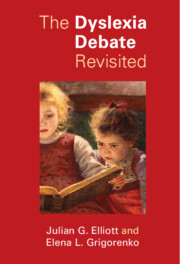168 results
Contents
-
- Book:
- The Dyslexia Debate Revisited
- Published online:
- 30 March 2024
- Print publication:
- 18 April 2024, pp v-v
-
- Chapter
- Export citation
Index
-
- Book:
- The Dyslexia Debate Revisited
- Published online:
- 30 March 2024
- Print publication:
- 18 April 2024, pp 424-428
-
- Chapter
- Export citation
References
-
- Book:
- The Dyslexia Debate Revisited
- Published online:
- 30 March 2024
- Print publication:
- 18 April 2024, pp 300-423
-
- Chapter
- Export citation
Chapter 4 - Assessment, Instruction, and Intervention
-
- Book:
- The Dyslexia Debate Revisited
- Published online:
- 30 March 2024
- Print publication:
- 18 April 2024, pp 183-245
-
- Chapter
- Export citation
Chapter 1 - What Is Dyslexia?
-
- Book:
- The Dyslexia Debate Revisited
- Published online:
- 30 March 2024
- Print publication:
- 18 April 2024, pp 1-61
-
- Chapter
- Export citation
Foreword
-
- Book:
- The Dyslexia Debate Revisited
- Published online:
- 30 March 2024
- Print publication:
- 18 April 2024, pp ix-xvi
-
- Chapter
- Export citation
Chapter 3 - The Neurobiological Bases of Reading Disability
-
- Book:
- The Dyslexia Debate Revisited
- Published online:
- 30 March 2024
- Print publication:
- 18 April 2024, pp 118-182
-
- Chapter
- Export citation
Preface
-
- Book:
- The Dyslexia Debate Revisited
- Published online:
- 30 March 2024
- Print publication:
- 18 April 2024, pp xvii-xix
-
- Chapter
- Export citation
Abbreviations
-
- Book:
- The Dyslexia Debate Revisited
- Published online:
- 30 March 2024
- Print publication:
- 18 April 2024, pp xx-xxii
-
- Chapter
- Export citation
Chapter 5 - Dyslexia
-
- Book:
- The Dyslexia Debate Revisited
- Published online:
- 30 March 2024
- Print publication:
- 18 April 2024, pp 246-284
-
- Chapter
- Export citation
Figures
-
- Book:
- The Dyslexia Debate Revisited
- Published online:
- 30 March 2024
- Print publication:
- 18 April 2024, pp vi-vi
-
- Chapter
- Export citation
Copyright page
-
- Book:
- The Dyslexia Debate Revisited
- Published online:
- 30 March 2024
- Print publication:
- 18 April 2024, pp iv-iv
-
- Chapter
- Export citation
Table
-
- Book:
- The Dyslexia Debate Revisited
- Published online:
- 30 March 2024
- Print publication:
- 18 April 2024, pp vii-viii
-
- Chapter
- Export citation
Chapter 2 - Explanations at the Cognitive Level
-
- Book:
- The Dyslexia Debate Revisited
- Published online:
- 30 March 2024
- Print publication:
- 18 April 2024, pp 62-117
-
- Chapter
- Export citation
Chapter 6 - Conclusions and Recommendations
-
- Book:
- The Dyslexia Debate Revisited
- Published online:
- 30 March 2024
- Print publication:
- 18 April 2024, pp 285-299
-
- Chapter
- Export citation

The Dyslexia Debate Revisited
-
- Published online:
- 30 March 2024
- Print publication:
- 18 April 2024
The Timing of Diagenesis and Thermal Maturation of the Cretaceous Marias River Shale, Disturbed Belt, Montana
-
- Journal:
- Clays and Clay Minerals / Volume 62 / Issue 2 / April 2014
- Published online by Cambridge University Press:
- 01 January 2024, pp. 112-125
-
- Article
- Export citation
Index
-
- Book:
- The Publications of the Bedfordshire Historical Record Society
- Published by:
- Boydell & Brewer
- Published online:
- 18 July 2023, pp 181-198
-
- Chapter
- Export citation
Contents
-
- Book:
- The Publications of the Bedfordshire Historical Record Society
- Published by:
- Boydell & Brewer
- Published online:
- 18 July 2023, pp v-vi
-
- Chapter
- Export citation
Abbreviations and Symbols
-
- Book:
- The Publications of the Bedfordshire Historical Record Society
- Published by:
- Boydell & Brewer
- Published online:
- 18 July 2023, pp vii-viii
-
- Chapter
- Export citation



